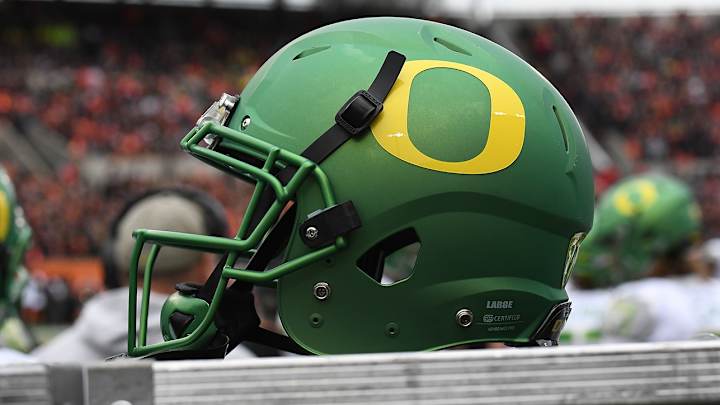Can a workout be too intense? Four key points on muscle condition rhabdomyolysis

Don’t stop. Push to the limit. Keep going. Those are the familiar phrases used to motivate elite athletes and regular gym-goers alike. But last week’s hospitalization of three Oregon football players after several intense off-season workouts has brought new attention to the way athletes train and projected a rare condition into the spotlight. Rhabdomyolysis—known as rhabdo for short—is a condition in which muscles break down rapidly and release the enzyme myoglobin (and creatine kinase) into the bloodstream, which can cause kidney damage.
Offensive linemen Doug Brenner and Sam Poutasi and tight end Cam McCormick checked into PeaceHealth Sacred Heart Medical Center at RiverBend in Springfield, Ore., in early January with exercise-related complaints, The Oregonianfirst reported. Poutasi's mother said that her son complained of sore arms after the workouts—described as “akin to military basic training,” including “up to an hour of continuous push-ups and up-downs”—and had been diagnosed with rhabdomyolysis.
“When you work out you do small amounts of muscle damage and that’s fine, that’s what makes you stronger. Your body repairs it and that’s when hypertrophy occurs,” says Dr. Michael M. Joyner, an expert in human performance at the Mayo Clinic. “But if you do too much and really break the muscle down, that’s where the myoglobin gets in your system.”
Most people have experienced muscle soreness after a hard workout. So what defines “too much” when it comes to working your muscles? How far is too far when pushing to the limit? Joyner says there are four key factors all athletes should be aware of to prevent the risk of developing rhabdomyolysis.
Get the most out of your workouts with these tips from a former pro boxer and NFL trainer
Detraining
A lot of rhabdomyolysis cases are seen when people have taken a few weeks or months off and jump right back in, Joyner says. Inexperienced exercisers need to use caution, but even skilled, elite athletes who are coming off a vacation or extended break from fitness—also known as detrained athletes—are at risk if workouts aren’t adjusted according to the current state of fitness.
"Detrained individuals know how to push themselves and are usually committed to doing a certain workout,” Joyner says. “They are sometimes overconfident and think they can get right back in and do a novel exercise, typically ones that are associated with temporary muscle damage.”
Eccentric training
Also described as negative training, eccentric exercises are slow, downward movements that aim to lengthen the muscle, rather than contract it. For example, during a dumbbell curl exercise, the eccentric movement is the lowering of the weight back down—when your muscles are resisting the weight—after performing the concentric contraction of the bicep muscle. This technique allows athletes to “leave it all out there,” or train until failure. (You can read more on that here.) But Joyner warns detrained athletes about doing eccentric movements, especially with high intensity and volume.
“Eccentric exercise is the sort of exercise that makes you sore—starting and stopping, downhill running, up-downs, burpees,” he says. “It is usually some kind of new exercise. It’s eccentric contractions and pushing to failure without the right sort of preparation [that] can be harmful.”

Square wave approach
At a basic level, a square wave can be defined as something that varies abruptly in amplitude between two fixed values, spending equal time at each. Think of it in terms of drawing a line: you can draw a zig-zag line with saw-toothed point; a sine line with gentle curves; or a square line, with right-angled edges and squared-off points.
Taking a square wave approach back into exercise is to abruptly begin intense workouts after a period of rest, Joyner says.
“Instead of doing 10 minutes of X on day 1 and 20 on day 2, and so on, they will go right back into 60 minutes of intense work,” he says. “The key is to start slow and build into things. Coaches and trainers have to know their athletes, what their goals are and how to collaborate with them to improve.”
Joyner says competition can also play a role, as athletes will try to outdo or challenge each other.
Dehydration
“Adding concurrent heat stress or dehydration to [the aforementioned factors] can make matters worse,” Joyner says. “And because dehydration reduces blood flow to your kidneys, it makes it harder for your kidneys to flush out the myoglobin.”
Some evidence also shows that people with certain conditions, such as neuromuscular diseases or those with sickle cell trait, can be more susceptible to rhabdomyolysis, Joyner says.
Symptoms of rhabdomyolysis vary depending on the muscles affected but usually involve muscle pain, swelling and tenderness. In addition, dark, discolored urine can develop, indicating kidney damage. Urine and blood tests will be done to confirm the diagnosis.
The incident with the Oregon football team is not the first case of rhabdomyolysis in college athletics—in August, eight female volleyball players from Texas Woman’s University were treated for the condition, and in 2011, 13 athletes at the University of Iowa’s football program were hospitalized after an intense workout. On Tuesday, Oregon announced that strength coach Irele Oderinde had been suspended without pay for one month.
Best running and workout accessories for your new iPhone 7 and iPhone 7 plus
For the everyday athlete, Joyner says the risk is minimal if people are realistic and smart, especially after time away from the gym.
“You are trying to improve your health. You can’t improve if you don’t train, and you can’t train if you are injured, sore, or otherwise wiped out,” he says. “The point is conditioning, not punishment.
“A lot of the [strength and conditioning] people in big programs play a role as motivators because they are close to the athletes,” he says. “But with that comes a real responsibility.”
